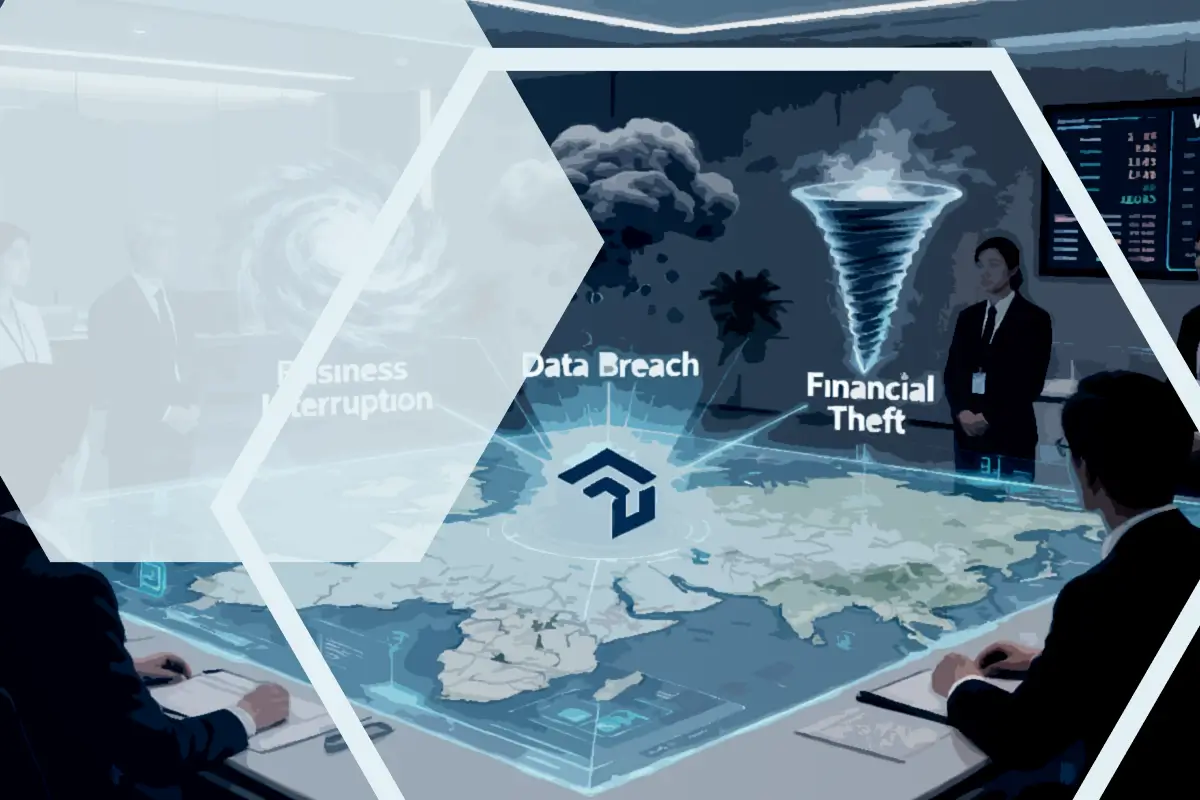In July 2024, the cybersecurity landscape experienced a significant event when a routine software update from CrowdStrike, a leading security firm, resulted in a global IT disruption. An error within their system update caused widespread systematic failures, impacting over 8.5 million Windows devices across crucial sectors such as healthcare, banking, and transportation.
This incident emphasizes the need for organizations to adopt a holistic approach to cyber risk management that considers a variety of threats, reaching from malicious malware attacks to accidental system failures, such as the CrowdStrike incident.
This article highlights the critical need for a comprehensive understanding of cyber risk across the entire threat landscape to capture the entire enterprise-wide cyber risk. Also it shows how to effectively assess cyber risk at an enterprise level with strategic, top-down risk quantification.
The Importance of Measuring Enterprise-Wide Cyber Risk
Lessons from the CrowdStrike Incident
The CrowdStrike incident demonstrated how a single point of failure can disrupt operations across multiple sectors. The global scale of this disruption - grounding flights, crippling hospital systems, and halting financial transactions - was a direct result of an interconnected digital ecosystem that relies on a single cybersecurity vendor. This incident highlights the critical need for a comprehensive understanding of cyber risk across the entire threat landscape rather than a narrow focus on isolated threats to capture the entire enterprise-wide cyber risk.
Why Measuring Cyber Risk Across the Entire Enterprise Matters
The increasing complexity of cyber threats, exemplified by the CrowdStrike incident, has made cyber risk management a boardroom issue. The financial, legal, and reputational damage that can result from such disruptions is significant, making it imperative that organizations have a clear, quantified understanding of their risk exposure.
Quantifying cyber risk through a top-down approach allows organizations to anticipate potential threats holistically and allocate resources effectively. By translating these digital threats into financial loss metrics, business leaders can prioritize risk and align cybersecurity initiatives with overall business objectives.
Enterprise-Wide Top-Down Cyber Risk Quantification: Incorporating Lessons from the CrowdStrike Incident
The CrowdStrike incident provides a real-world example of how a failure to fully understand and manage cyber risk can lead to significant disruptions. The incident’s individual impact on an enterprise’s running business process highlights the importance of understanding, categorizing, and mitigating cyber risks before they result in widespread damage. Had organizations assessed their enterprise-wide cyber risk earlier, the impact of business interruption could have been anticipated, managed, and coordinated in a better manner.
Effective enterprise-wide cyber risk quantification requires a top-down approach, as this methodology is effective in capturing a variety of cyber incidents that can occur in an enterprise. In contrast to conventional bottom-up methods, where organizations focus on typical isolated risk scenarios to quantify cyber risk, the top-down approach considers the entire threat landscape and its potential effect on an individual organization. This makes the top-down cyber risk quantification approach particularly effective for large organizations where risks can propagate across different parts of the enterprise. By aggregating data from multiple sources across the entire organization, this approach enables a rapid assessment of overall risk exposure and helps prioritize the most significant threats.
Step-by-Step Process of Assessing Enterprise-Wide Cyber Risk with Squalify
Squalify’s top-down cyber risk quantification (CRQ) platform specializes in providing enterprise-wide cyber risk assessments for strategic decision-making at the board level.
With Squalify, you can quantify your enterprise-wide cyber risk in three steps:
- Scope the Quantification: Before you begin quantifying your cyber risk with Squalify, you must clearly define the purpose and scope of the quantification by identifying income streams, business units, and legal entities critical for cyber incidents.
- Quantify Critical Cyber Risk Scenarios: Use a guided questionnaire to assess the company’s worst-case severity for different cyber risks. Our top-down approach mainly requires easily collected and publicly available company data, such as number of employees or annual revenue. In addition, a pre-parametrized Monte Carlo simulation allows the generating of different probabilistic output metrics, such as the Value-at-Risk (VaR).

- Prioritize Risk Mitigation Options: Model the potential financial impact of different loss scenarios to strategically plan and validate enterprise-wide cyber risk decisions. Cyber security improvement programs can be simulated based on the highest financial impact scenarios for the organization to prioritize the most effective enterprise-wide mitigation options.

In addition, Squalify’s subsidiary steering capability allows you to monitor and benchmark the cyber exposure and performance of various legal entities within your group, enabling seamless oversight of your entire organization’s cyber risk profile, even on a global scale.

Final Words
The CrowdStrike incident is a powerful reminder of the importance of enterprise-wide cyber risk management that incorporates not only anticipated isolated scenarios but also cyber scenarios across the entire threat landscape. It demonstrates that no organization is immune to cyber threats in today’s interconnected world.
However, the ability to gain an enterprise-wide overview of cyber risks will help organizations better prioritize and mitigate different cyber risk scenarios.
The Squalify platform provides the necessary capabilities to quantify and strategically manage your enterprise-wide cyber risk and support decision-making at the highest organizational levels. Schedule a demo now to learn more about how you can quantify and manage your company-wide cyber risk.









